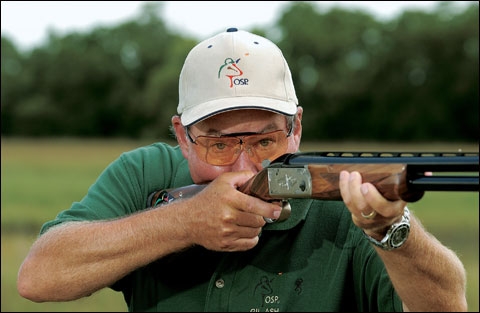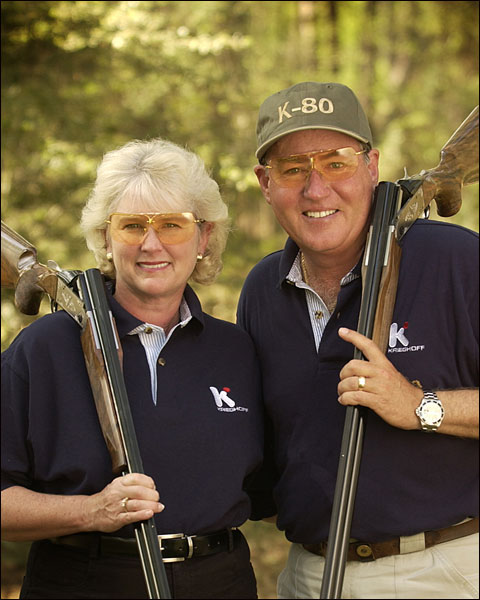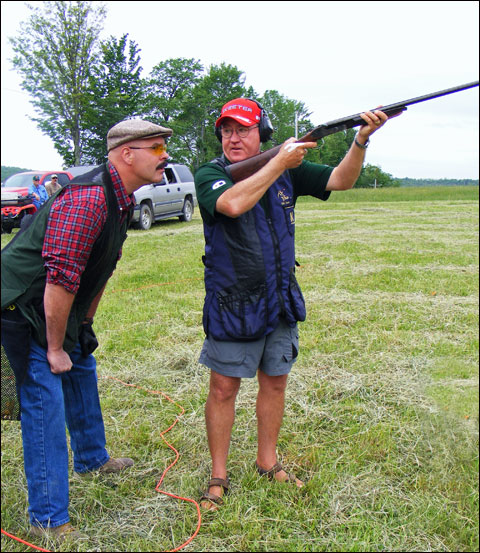Gil Ash on Mastering Peripheral Acceptance: How to Take Your Clays Scores From 50 to 90 by Rebuilding Your Comfort Zone

I sat across the picnic table from shotgun instructor extraordinaire, Gil Ash, as he drew a simple diagram on the yellow legal pad between us. At first it looked like ripples emanating out, but then he started adding numbers to the curved lines until he finally turned around the pad to face me.
As our conversation continued, he explained that what lay before me was a visual representation of his philosophy called Peripheral Acceptance. The way Mr. Ash explains it, any clays shooter who masters Peripheral Acceptance can dramatically improve their score average and consistency.
If you think Peripheral Acceptance is some wild-eyed claim by an unknown upstart, nothing could be further from the truth.
 Gil and Vicki Ash of the Optimum Shotgun Performance Shooting School.
Gil and Vicki Ash of the Optimum Shotgun Performance Shooting School.Mr. Ash, and his wife Vicki, own the Optimum Shotgun Performance Shooting School, or OSP for short, in Fulshear, Texas. The Ashes have published 10 books (print and audio) and six videos about clays shooting. In terms of overall visibility and revenues, they are arguably the most successful shotguns instructors in America – frequently taking to the road for shooting clinics.
The notion of Peripheral Acceptance has always been inherent in the Ash’s fundamentals of clays shooting: you hold the muzzle closer to the break point rather than the focal point (where you first establish the target).
Mr. Ash made me swear that Shotgun Life would not publish his diagram, since it’s the basis of their forthcoming eleventh book, but I did get an up-close and personal look at Peripheral Acceptance in action, and what it takes to master the technique.
I spent 48 hours with Mr. Ash at the 2011 Great Northeast Side by Side Classic, held June 3-5, at Hausmann’s Hidden Hollow Sporting Clays in Susquehanna County, Pennsylvania. We talked theory at the picnic table overlooking the flurry course and then drove out to a field on the property where I attended several lessons with him.
 Gil Ash
Gil AshDuring a rare break in his instruction schedule, he gave me a 40-minute session on Peripheral Acceptance using my vintage side by side.
So what exactly did Mr. Ash draw on that yellow legal pad?
As he explained it, in order for the gun to be ahead of the bird and the shooter to be focused on the bird, the shotgun must be in the periphery. And in the beginning Peripheral Acceptance is interpreted as lead, or in other words: how far out in the periphery is the shooter comfortable with the gun without wanting to look at it, check the lead and consequently stop the gun during the critical swing?
Eventually a shooter becomes more experienced in pointing the shotgun ahead of a target. At the same time, the shooter maintains their focus on the target, and in turn they begin to be able to let the gun go farther and farther out in front of the target… that is until they reach a point where they are no longer comfortable, check the lead, take their eyes off the target, which is when the gun stops, and ultimately they miss behind the bird.
This would be the shooter’s Peripheral Acceptance, and as long as the shooter is shooting a target where the necessary lead is within their Peripheral Acceptance they are successful; but when the lead is greater than their Peripheral Acceptance they can’t consistently let the gun get far enough in front of the target to break it – in other words, they can’t leave their comfort zone. In terms of distance, the comfort zone for most shooters is about 4 feet or 4 inches, regardless of how you describe what you see, and this is why the majority of shooters are trapped in the high 70s.
Mr. Ash’s diagram showed that most shotgun shooters start with a Peripheral Acceptance of 6 inches and they tend to shoot scores in the 50s. If they really stretch themselves, they can extend their Peripheral Acceptance to 2½ feet and increase their scores to the 62-70 range.
“The world is trapped at not letting the gun go more than 2½ or 3 feet in front of the bird,” he said.
And by trapped, he’s talking about a near-paralysis of getting beyond that limit. He explained that he’s seen shooters break their first target out past 2½ feet, but miss the second target because they couldn’t sustain their extended Peripheral Acceptance.
He gave this example: how many times have you been at a station looking at a “hard, long target” and without a moment’s hesitation called for the target and the gun just goes way out there and the target breaks and after the shot you exclaim how far in front of the target you were when you saw it break? Now you know you can do it because you just did it, and you know what it looks like, but you can’t do it again to save your life. According to Mr. Ash, this is a great example of what the subconscious can accomplish if you can get out of its way (and break the target the first time). It also illustrates how the fear of missing will not let the gun go back out there to the correct Peripheral Acceptance because it’s beyond your comfort zone. Out of fear, you once again retreat to your comfort zone and miss the target.
That 2½ feet gets further compressed by the stunted hold point of most shooters. The hold point, or where you start your shotgun, is generally a dismal 6 inches from the trap machine, according to Mr. Ash. So there you are, holding way too close to the trap machine and then, once you call for the bird it gets way ahead of you and now you are just trying to catch up to it and you race to gain the proper lead but hit the wall of your comfort zone at 2½ feet and miss behind.
The puzzling thing is that the targets looked a lot slower when you were looking at them than when you were shooting at them. This is where Peripheral Acceptance allows you to slow the targets down.
If you are able to shift your hold point out to ⅔ or ¾ of the way between the focal point and the break point when the target is thrown, the shooter can then begin slowly moving their muzzles toward the break point and merge them in front of the target and at the same speed of the target and this will make the target slow down and seem to float. When the target and the gun are both going the same speed then the target has no speed and as long as the gun is in front of the target then the lead becomes very forgiving.
Think about it: when you are in 70 miles-per-hour traffic things are moving slow, but when you look at the same traffic standing on the side of the road things are a lot faster. Playing farther away from the trap allows the shooter to merge the muzzles into the front of the target and control the visual speed of the target and makes the lead more forgiving provided the lead is within the shooters Peripheral Acceptance.
 Gil instructing Dr. Russ Burkett at Hausmann’s Hidden Hollow Sporting Clays.
Gil instructing Dr. Russ Burkett at Hausmann’s Hidden Hollow Sporting Clays.“Everybody has a certain comfort zone,” Mr. Ash observed. “The problem comes when people have to leave their comfort zone.”
I saw this phenomenon during the few lessons I attend by Mr. Ash at the 2011 Great Northeast Side by Side Classic. After a client became comfortable with their greater Peripheral Acceptance and really started breaking targets consistently, they would invariably retreat back to their original comfort zone and start missing target after target. It was incredible. Mr. Ash would then once again have to shepherd them out of their familiar 2½ foot comfort zone before they could break targets again without fail using their newly acquired longer Peripheral Acceptance.
A key secret to extending your Peripheral Acceptance is to “let the bird come to the lead,” he said. “Instead of mounting the gun too close to the bird and have to move the gun out to the bird, you merge with the target like merging like a car on the freeway. You let the bird come to the lead, instead of mounting the gun too close to the bird and having to move out to the bird. You’ll see that the bird will fly slower and the lead will take care of itself as long as the lead is not greater than your Peripheral Acceptance.”
In short, he means that if you want to reduce your lead and in turn minimize your gun movement, you have to learn how to extend your Peripheral Acceptance.
“As your Peripheral Acceptance grows, the amount of lead that you see lessens dramatically,” he said.
But moving your shotgun farther out might not in itself be sufficient.
“The biggest mistake people make is mounting the gun between the bird and the necessary lead to break the bird because their Peripheral Acceptance won’t let them mount the gun far enough in front of the target,” he elaborated. “What our research has proven is that if the gun is too far in front to break the target it is a subconscious act for the brain to slow the timing cycle down until the lead is correct. Hard to believe but I did it and it works.”
I realize that this may be hard to believe, but I tried it and it works.
Why?
“It’s the fear of missing that prevents you from putting the gun out there,” he elaborated. “It’s all fear based decision making. Once you get rid of the fear, the whole game gets easier.”
One step to expanding your Peripheral Acceptance is learning to separate your eyes from the barrel. The best way to do that involves following the target with your nose. So you look back at the trap machine in order to establish the target early, while holding your gun out near the break point – even if it’s 30 yards or more. Watching the target, you then follow its line with your nose as it merges with the shotgun. The farther away from the trap machine you can hold the shotgun, the greater your Peripheral Acceptance.
“The focal point is always at the trap. You want to get the target input as soon as you can,” Mr. Ash said. “Once you get your nose on the bird, and get in front of the bird, as they (gun and bird) come together you start breaking the birds.”
Now contrast this method with the way most shooters currently attempt to break a target – let’s say a full crosser. They would hold the shotgun 6 inches from the trap machine, trying to sustain a lead that would ultimately be no greater than 2½ feet. Now what happens when that crosser is 30 yards out?
After you’ve maxed out your Peripheral Acceptance of 2½ feet, you are really scrambling to maintain the necessary lead to break the target because you’ve left your comfort zone.
“The problem comes when the necessary lead is greater than their comfort zone, because they’re not willing to play farther away from the bird,” he said.
Mr. Ash calls chasing the target “barrel dragging.”
“The normal shooter has the gun back where the trap is and starts moving the gun,” he said “I call them barrel draggers. They try to get it in front of the bird and they can barely do it. If they start their gun three-quarters in front of the bird and merge with it they’ll kill that bird. Don’t be a barrel dragger.”
As he observed: “The pros, the good guys, they push the gun farther out. They never get jammed; the bird’s not the fastest thing in the picture and they rarely if ever get confused by focusing on the gun. All the top competitors are shooting with much less movement than ever even in skeet. Top shooters never get jammed, the targets just float to them. As you get better and become a better shooter with experience where the gun has to be further away from the bird, then your Peripheral Acceptance becomes greater and greater and greater.”
There are incremental improvements the closer you hold your shotgun to the breakpoint. Ultimately, a shooter who can master Peripheral Acceptance at 30 feet or greater is most likely to shoot in the 90s.
He touched upon some techniques to help students expand their Peripheral Acceptance …
- Look at the target down the side of your shotgun or across the muzzle of your shotgun – not down the rib. The muzzle and the target can never share the same place.
- Follow the target with your nose. Most people put their nose over the barrel and cut their eyes toward the target. By cutting your eyes, you see the target but you cannot focus on it.
- If you don’t care about winning you’ll increase your Peripheral Acceptance. By that, Mr. Ash meant that you have to leave your comfort zone – the 2½ feet or so where you’re accustomed to shooting.
- You have to lose enough times to realize that target lead doesn’t work as well as Peripheral Acceptance. “It’s attrition that creates skill, not knowledge,” he said.
- You have to put in the time and practice, practice, practice.
- It’s easier to visualize the target with a greater Peripheral Acceptance. Otherwise, you visualize yourself chasing the target.
- Basically, you have to walk the Peripheral Acceptance walk if you’re willing to try it. You just can’t think about it. “You don’t think your way to the right action. You have to act your way to the right thinking.”
Fresh on the heels of my 48 hours with Mr. Ash, I visited one of the sporting clays courses that I usually frequent, The Prince George’s County Skeet & Trap Center in Glen Dale, Maryland. I shot the 12-gauge semi-auto that I typically use on sporting clays.
How did I do? Scores were up. Here are some examples of reports pairs thrown…
Station 2 was a rabbit and a slow outgoer: 5/6
Station 3 threw two slow incomers: 6/6
Station 4 presented two high, fast outgoers: 5/6
Station 5 was a high outgoer and a chandelle: 5/6
Station 6 delivered two high outgoers: 6/6
Station 7 threw an overhead outgoer and incomer: 6/6
Well, by now you pretty much get the idea. For me, these scores were higher than average for that course.
Today, I continue to refine my technique to expand my Peripheral Acceptance. Generally, the places we shoot sporting clays refrain from exceedingly long targets and so I get to practice on shorter and mid-range presentations.
The one target that continues to elude me with a greater Peripheral Acceptance, however, is the low, fast, dropping crosser. No matter how hard I try, I need to hold the shotgun further back to gain the swing momentum.
I still have to remember Mr. Ash’s final word of advice: “You don’t go from 2 feet to 20 feet of Peripheral Acceptance overnight. You have to practice. That’s why it takes so long to get good at this game.”
Irwin Greenstein is the Publisher of Shotgun Life. You can reach him at letters@shotgunlife.com.
Useful resources:
The OSP Shooting School web site
Hausmann’s Hidden Hollow Sporting Clays web site
Prince Georges County Skeet & Trap Center web site

Irwin Greenstein is Publisher of Shotgun Life. Please send your comments to letters@shotgunlife.com.


Comments